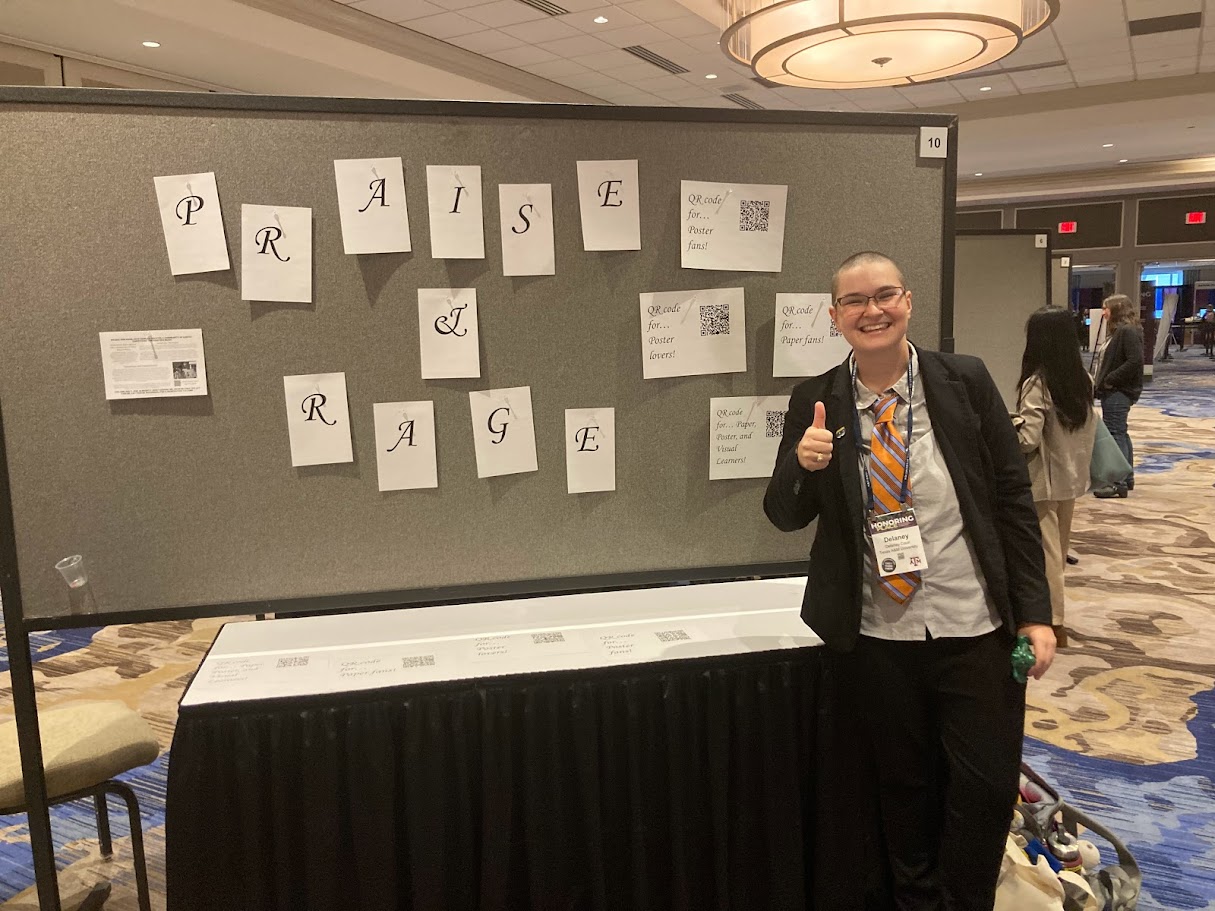March 2025

How To Create a Conference Presentation
By Delaney Couri
This semester, I am applying for jobs, finishing a dissertation, teaching an online course, and preparing to move… Oh, and I also somehow signed myself up to deliver four different conference or colloquium presentations.
*Face Palm* I am already incredibly busy, whatever could I gain from these? I don’t even want to go into academia? What the heck, Delaney?!
This has been my internal dialogue for the past week as I stare at my schedule with what can only be described as awe and terror. On March 6th, I have a presentation to deliver over my entire dissertation. Which should be easy, since it’s not written yet and only will end up being around 120 pages. No big deal.
Sometime during the week of March 17th, I will present over just one chapter of my dissertation. I can not tell you which one because right now, I honestly do not remember which one I submitted. Plus, I submitted that application so long ago, I doubt my project resembles that initial submission at all. Totally cool. I got this.
On April 3rd, I will fly to a city I’ve never been to in order to present a paper I wrote three years ago, edited a year and a half ago, and have not looked at since. That seems like a good idea, right?
Finally, on Easter weekend, I will fly to Boston, Massachusetts to present on another dissertation chapter. This one I do recall, but I can assure you that the proposal looks absolutely nothing like the chapter I will end up speaking on. The conference is based around Asian American scholarship and I nearly ended up cutting my Asian American character from my analysis… Thankfully, I did not. That would be tragic, huh?
Because I am scrambling to get all of my presentations done while finishing up my dissertation work, I thought I would make a little guide for myself and others to help streamline the process of creating conference presentations.
Step 1: Go back and read your paper. Seriously. I know this step is the absolute worst, but it is impossible to create a presentation based on a paper that you do not remember writing (believe me, I’ve tried…).
Step 2: Figure out what type of presentation you are giving. Are slides appropriate? How much time do you have? Are you presenting alone or on a panel? These questions are impossible to answer without going to the conference or colloquium page and looking at their tips and advice on what is needed for their specific discipline and conference. While some events, like Three Minute Thesis, have very specific guidelines, most do not… so feel free to be creative!
Step 3: Now that you know what your paper is about and what the conference is looking for, it is time to organize. Each good research paper should have some form of introduction, method, literature, data, analysis, and conclusion. Let’s examine each in turn…
Step 3a: The best way to introduce a conference port is by explaining your interest in the topic or its relevance to the world. I encouraged my freshman in a writing class to start with a story of their life. This may be heretical advice in a scientific field where you may want to rely on the importance of a topic rather than a story about say, a mechanical tool. Either way, you need to hook your audience quickly.
Step 3b: When explaining your method, consider the audience. If you’re speaking to others familiar with your discipline you may need less of an explanation of what *insert disciplinary jargon term here* means and can instead just rely on their understanding of your process. However, when you present outside your field, make sure you tell your audience what the method you are using looks like for your context, as something as rudimentary as “rhetorical analysis” means something different in English then it does in Communication.
Step 3c: Gathering literature is essential for setting up context and a theory for your work… it’s also really boring for most of your audiences. To best cover the literature you need, narrow to the most essential pieces and don’t let it take up too much time. This presentation is about you and your work— not someone else’s.
Step 3d: What your “data” looks like will vary based on method but a good place to start with this section is to create a visualization. A graph, a chart, even an image of an album cover if that’s what you’re studying. Data is important to share in a raw form so others can draw their own conclusions about your work. Visualize it for your audience to maximize engagement.
Step 3e: Analysis is where you should spend the majority of your time, slides, or poster. This is the contribution you are making, so feel free to elaborate on what you were able to ascertain from the research you did. A presentation that does not have an analysis is just a story… the real research is here.
Step 3f: A conclusion is a space to admit that you don’t know everything about your topic because you don't have the capacity to study everything. It doesn’t need to be long but in a conference space the conclusion can be a space to elicit collaborations or further research ideas. Take your time and wrap up with a call for input from your audience if they are scholars or a call to action if they are lay people.
Step 4: Now that you have all your pieces make it look pretty! Getting your content in order first gives you an idea of what you need to get on the page/slides/speech and then you can let your creativity take it from there! This step is also near the end so that if you are crunched for time you can skip it and your content won’t suffer.
Step 5: Put it all together on a flash drive, poster, notes app, or in your brain and get ready to go... Congratulations, you made a conference presentation!
